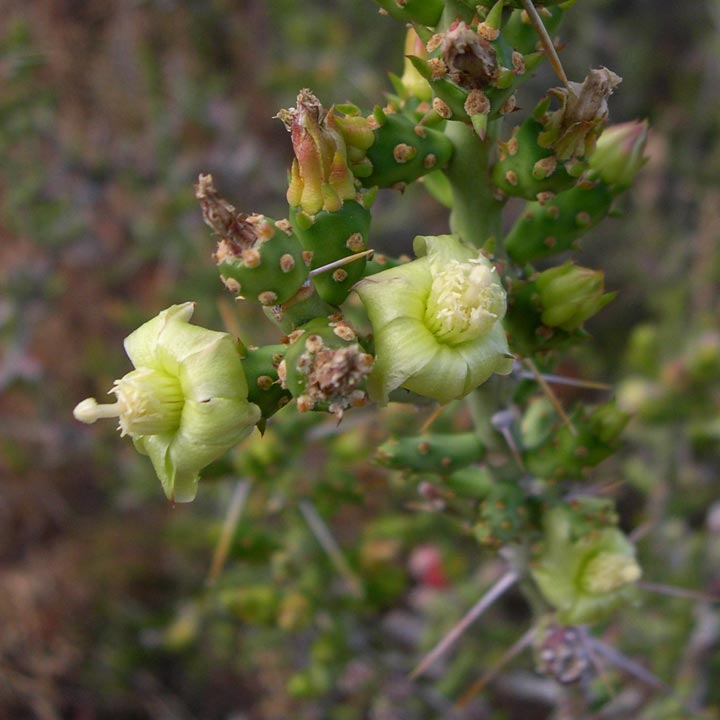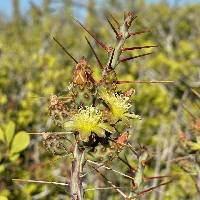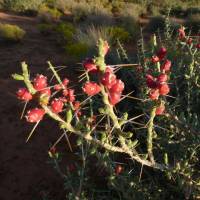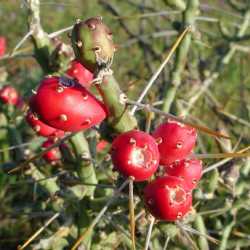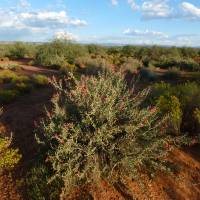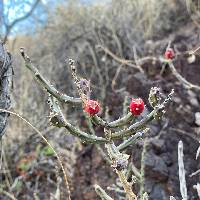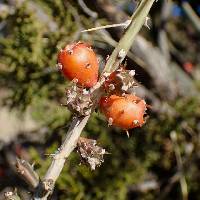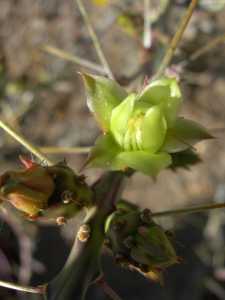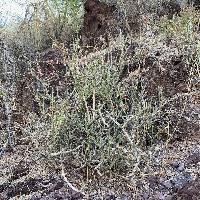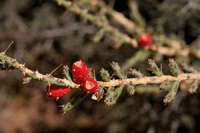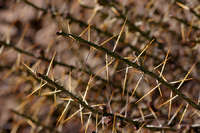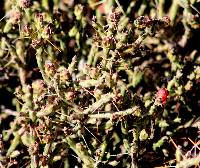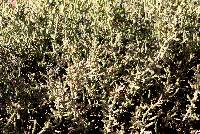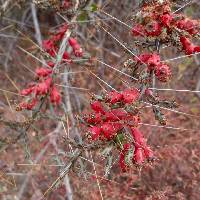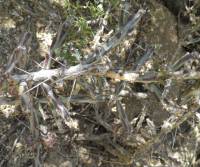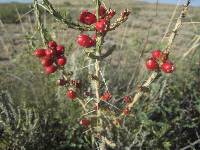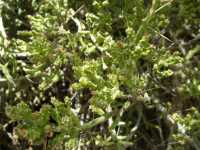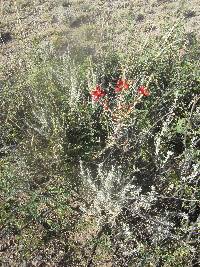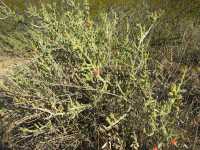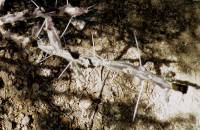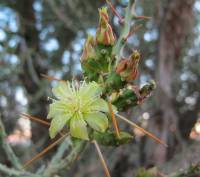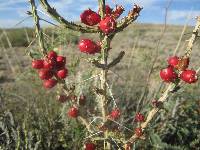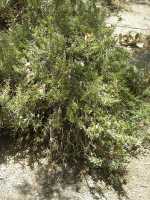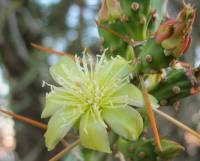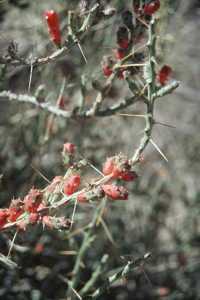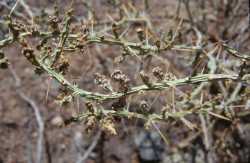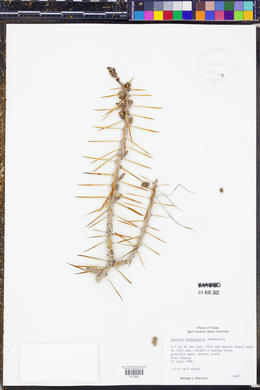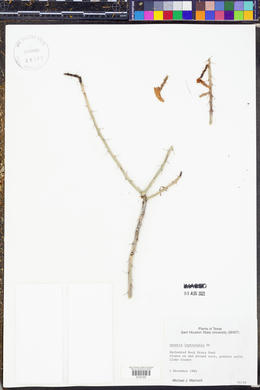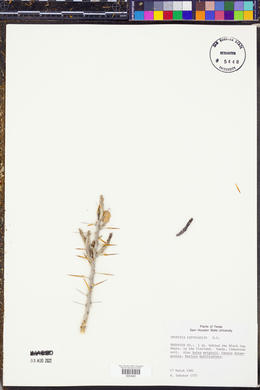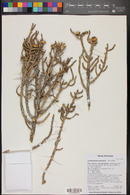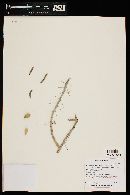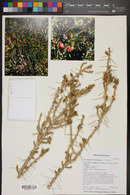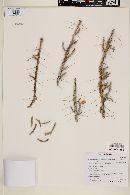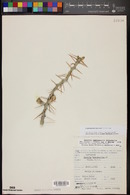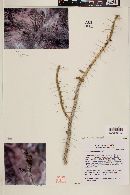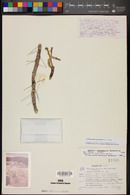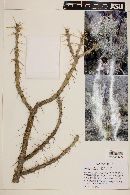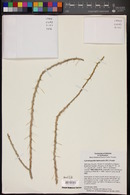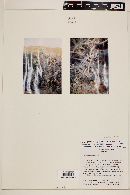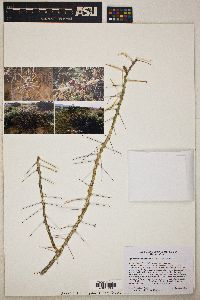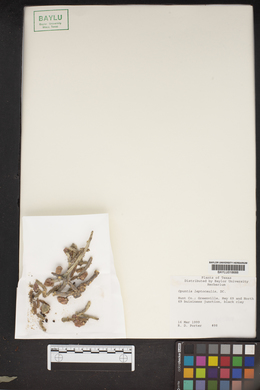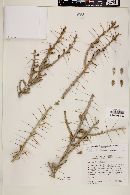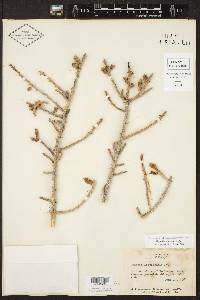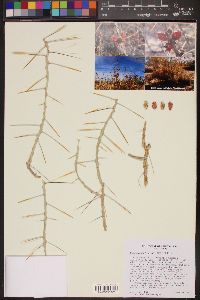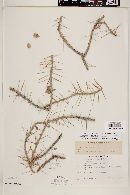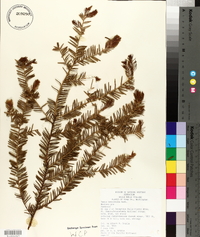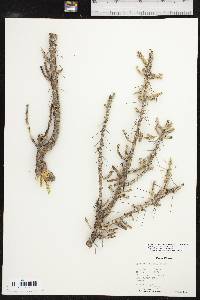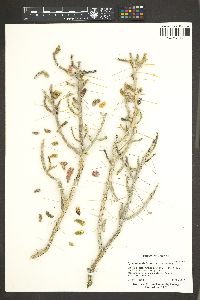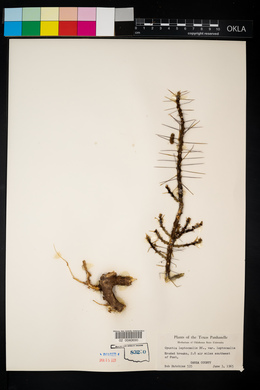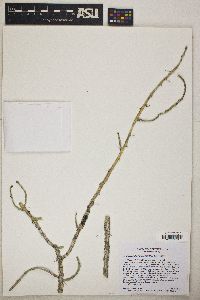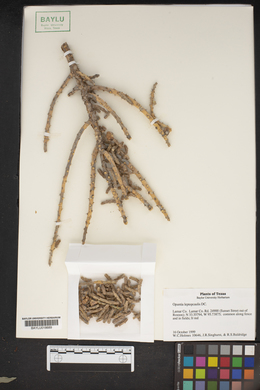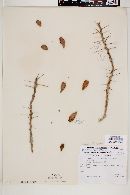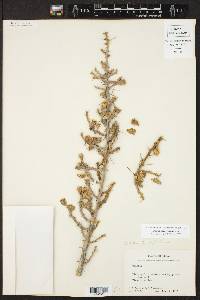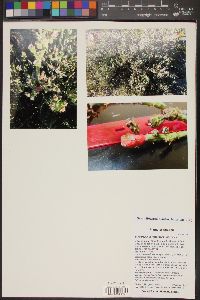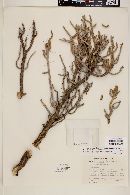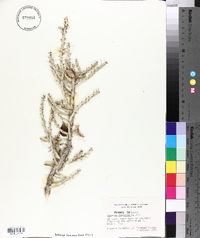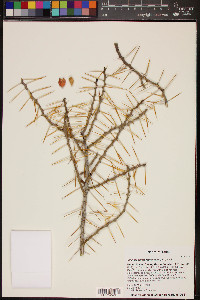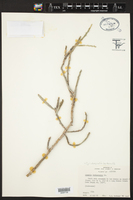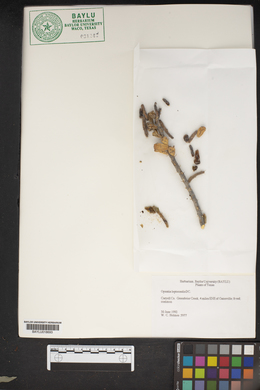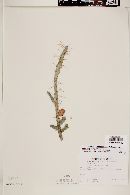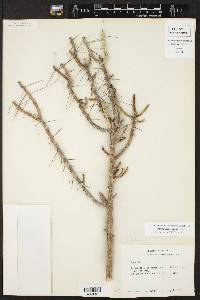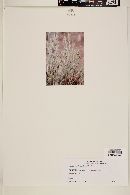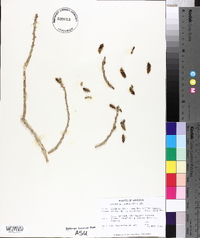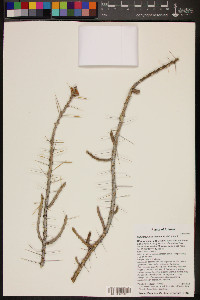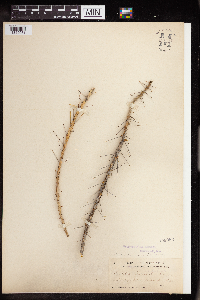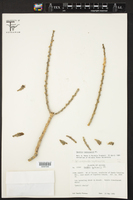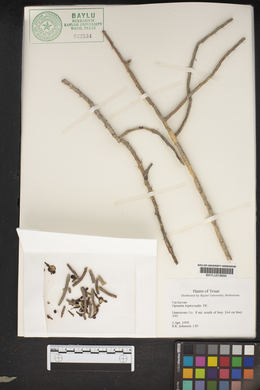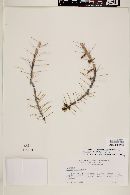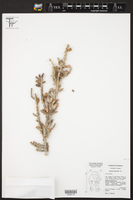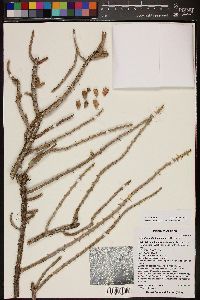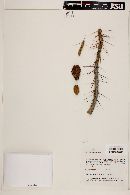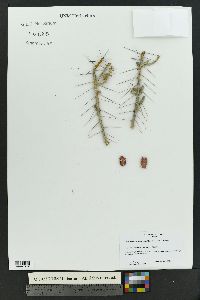Cylindropuntia leptocaulis
|
|
|
|
Family: Cactaceae
Christmas Cholla, more...desert Christmas cactus, tesajo cactus (christmastree cacti), Christmas cactus (es: tasajillo, alfilerillo, catalinaria)
[Cylindropuntia brittonii (J.G. Ortega) Backeb., moreOpuntia frutescens Engelm., Opuntia leptocaulis Dc., Opuntia leptocaulis var. brittonii (Gonzalez Ortega) Bravo, Opuntia leptocaulis var. leptocaulis , Opuntia vaginata Engelm.] |
Shrubs or small trees, sparingly to densely branched, 0.5-1.8 m, usually bearing similar, commonly spineless terminal branchlets arranged at right angles along major axes. Stem segments usually alternate, gray-green or purplish, 2-8 × 0.3-0.5 cm; tubercles linear, drying as elongate, riblike wrinkles, 1.1-2(-3) cm; areoles broadly elliptic, (1-)1.5-3.5 × 0.7-2 mm; wool white to yellow, aging gray. Spines 0-1(-3) per areole, usually in apical areoles to well distributed, erect, flexible, straight or arching upward or downward, red-brown with gray to whitish coat, tips yellow, aging red-brown, terete, angular-flattened basally, the longest (4-)14-45 mm; sheaths gray to purple-gray with yellow to red-brown tips or yellow throughout. Glochids in adaxial tuft or crescent to encircling areole, yellow or reddish brown, 1-3(-5) mm. Flowers: inner tepals pale yellow to greenish yellow, sometimes tipped red, narrowly obovate, 5-8 mm, acute, apiculate; filaments greenish yellow; anthers yellow; style yellow; stigma lobes greenish yellow. Fruits occasionally proliferating, yellow to scarlet (rarely green, sometimes tinged purple, becoming yellow), sometimes stipitate, obovoid, 9-15(-27) × 6-7(-12) mm, fleshy, smooth, spineless; umbilicus 2-4 mm deep; areoles 16-20. Seeds pale yellow, suborbicular to squarish and crenate in outline, warped, 3-4.5 mm diam., sides smooth, each with 1-3 large depressions; girdle smooth or with very narrow ridge. 2n = 22, 33, 44. Flowering spring-early summer, sometimes fall (Mar-Aug, Oct). Deserts, grasslands, chaparrals, oak-juniper woodlands, flats, bajadas and slopes, sandy, loamy to gravelly substrates; 40-1500 m; Ariz., N.Mex., Okla., Tex.; Mexico (Chihuahua, Coahuila, Durango, Nuevo León, Sonora, Tamaulipas, Zacatecas). Cylindropuntia leptocaulis forms hybrids with C. acanthocarpa var. major (see 3. C. ×tetracantha), C. arbuscula, C. fulgida, C. kleiniae, C. spinosior, C. versicolor (see discussion under C. ×tetracantha), and C. whipplei. Hybrids in central Arizona have flowers intermediate in size to the parents, narrow tuberculate stems bearing 0-1(-2) major spines per areole, and tuberculate, spineless, orange to red fruits. The chromosome number reported for hybrids is 2n = 22.
Plant: Shrubs or small trees, sparingly to densely branched, usually bearing many short, commonly spineless branchlets arranged along major axes, 0.5-1.8 m tall; STEM segments gray-green to purplish, very narrow, 20-80 mm long, 3-5 mm in diam; tubercles not prominent, linear, drying as elongate, rib-like wrinkles, 11-20(-30) mm long. AREOLES white- to yellow-felty, aging gray, broadly elliptic, (1-)1.5-3.5 mm long, 0.7-2 mm wide Leaves: SPINES essentially absent or mostly in apical areoles to well distributed, red-brown with a gray to whitish coat, the tips yellow, aging red-brown, terete, angular-flattened basally, erect, flexible, straight or arching upward or downward, 0-1(-3) per areole, the largest (4-)14-45 mm; sheaths gray to purple-gray with yellow to red-brown tips or yellow throughout. GLOCHIDS yellow to reddish brown, in an apical tuft or crescent to encircling the areole, 1-3(-5) mm long Flowers: inner tepals pale yellow to greenish yellow, sometimes red-tipped, narrowly obovate, acute, apiculate, 6-12 mm long; filaments greenish yellow, the anthers yellow; style yellow; stigmas greenish yellow. Fruit: green, sometimes tinged purple, becoming yellow (rarely), orange-red to scarlet at maturity , obovoid to stipitate obovoid, smooth, spineless, fleshy, with umbilicus 2-4 mm deep, occasionally proliferating, 9-15(-27) mm long, 6-7(-12) mm in diam.; areoles 16-20; SEEDS 3-4.5 mm in diam., pale yellow, suborbicular to squarish and crenate in outline, warped, the sides smooth, each with 1-3 large depressions, the girdle smooth or as a very narrow ridge, 3-4.5 mm in diam Misc: deserts (commonly with nurse plant), sandy, loamy to gravelly substrates, flats, bajadas and slopes to desert and plains grasslands to chaparrals and oak-juniper woodlands; 50-1500 m (200-5000 ft); Mar-Aug, Oct References: Pinkava, Donald J. 1999. Cactaceae. Ariz. - Nev. Acad. Sci. 32(1). Benson 1969, Benson 1982, FNA 2003, Pinkava 1999, Allred and Ivey 2012 Common Name: Christmas cactus Duration: Perennial Protected Status: Salvage restriced status in Arizona. General: Shrub-sized cactus, 0.5-1.5 m tall; stems jointed and branching mostly at right angles with an alternate branching pattern; stem segments gray-green or purplish, cylinder shaped, 2-8 cm long and 3-6 mm in diameter, with linear tubercles which look like elongate wrinkles when dried (tubercles are the regularly-spaced bumps along the stems; the tip of each tubercle has an areole with a cluster of spines emerging from it). Terminal stem joints are usually spineless. Spines: Spines emerge from broadly elliptic, woolly white to yellow areoles which turn gray with age. Spines usually 0-1 per areole, but occasionally up to 3 per areole; spines are erect, flexible, straight or arching, terete with an angular-flattened base; spine color is red-brown with grey-white coating and yellow at the tip; the longest spines are 14-45 mm long. Each spine has a grey, purple-grey, or yellow sheath, unless it fell off already. Each areole also has a tuft of yellow or reddish brown glochids (fine barbed bristles), 1-5 mm long. Flowers: Petals numerous, pale yellow to greenish yellow and sometimes red-tipped, narrowly obovate, 5-8 mm long, with a small pointed tip; stamens numerous, with filaments that are greenish-yellow, topped with yellow anthers; style yellow, topped with a ring of greenish-yellow stigma lobes. Fruits: Fruits fleshy, red (occasionally yellow), smooth or covered in minute glochids, obovoid, 1-3 cm long and 6-12 mm wide, with 16-20 areoles; seeds round to square-ish, 3-5 mm wide, pale-yellow. Ecology: Found on sandy, loamy, or gravelly soils in deserts, grasslands, chaparral, woodlands, flats, bajadas, and slopes, below 5,000 ft (1524 m); flowers March- August. Distribution: AZ, NM, TX, s OK; south to n MEX. Notes: Commonly known as Christmas cactus, this species is distinguished by the narrow stems (only about 1/2 cm in diameter) and the bright red fruits. This plant grows much taller when growing in a nurse plant association with mesquite or palo verde. Ethnobotany: Fruits were used to sweeten and add potency to tulbai, a beer-like beverage made by fermenting sprouted corn; the small fruits were also eaten raw. Etymology: Cylindropuntia comes from kylindros, for the cylinder-shaped stem segments, and the related genus Opuntia, from which this genus was segregated. Leptocaulis means slender-stemmed. Synonyms: Opuntia leptocaulis Editor: SBuckley 2010, FSCoburn 2015, AHazelton 2017 |
|
|
|

